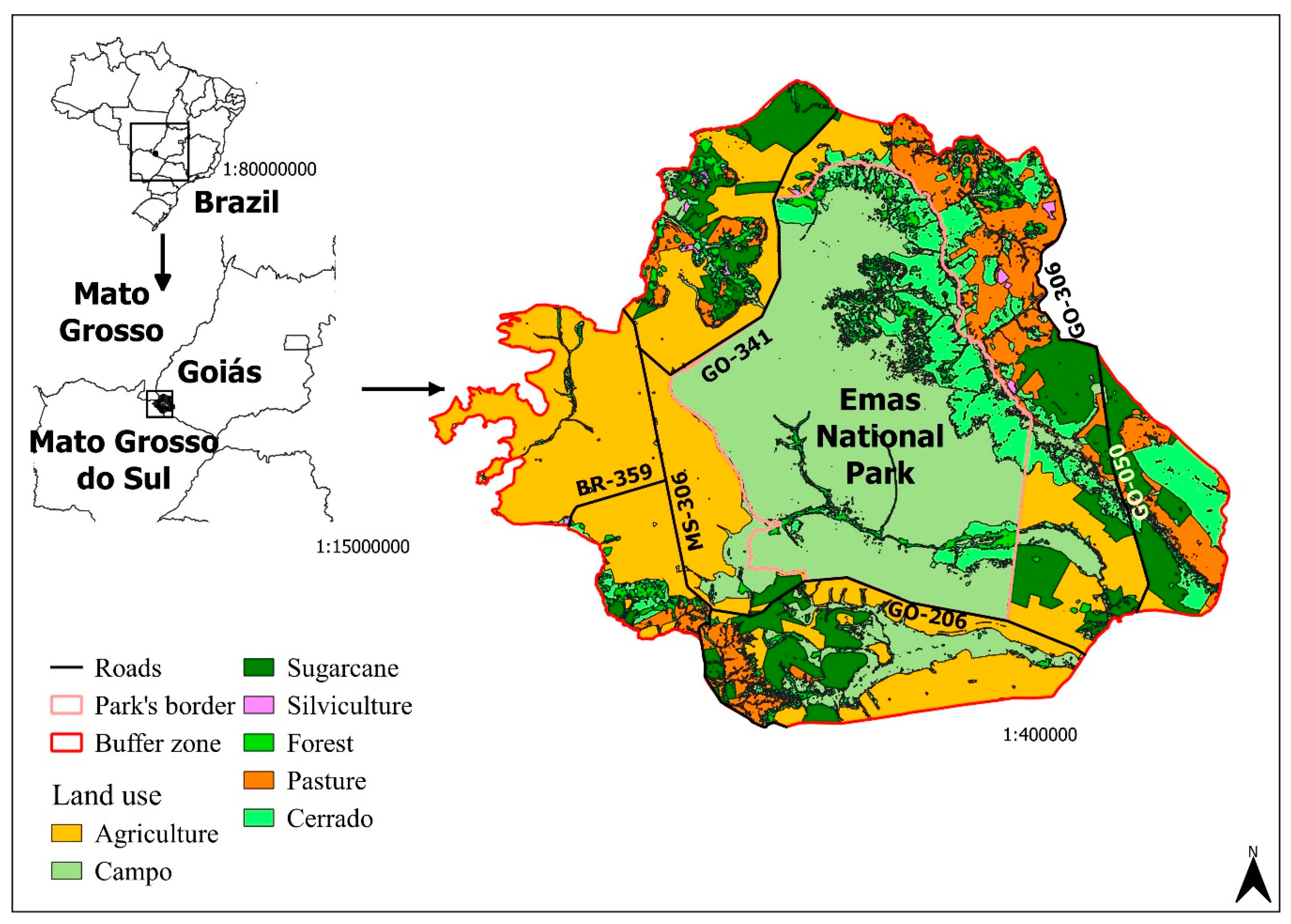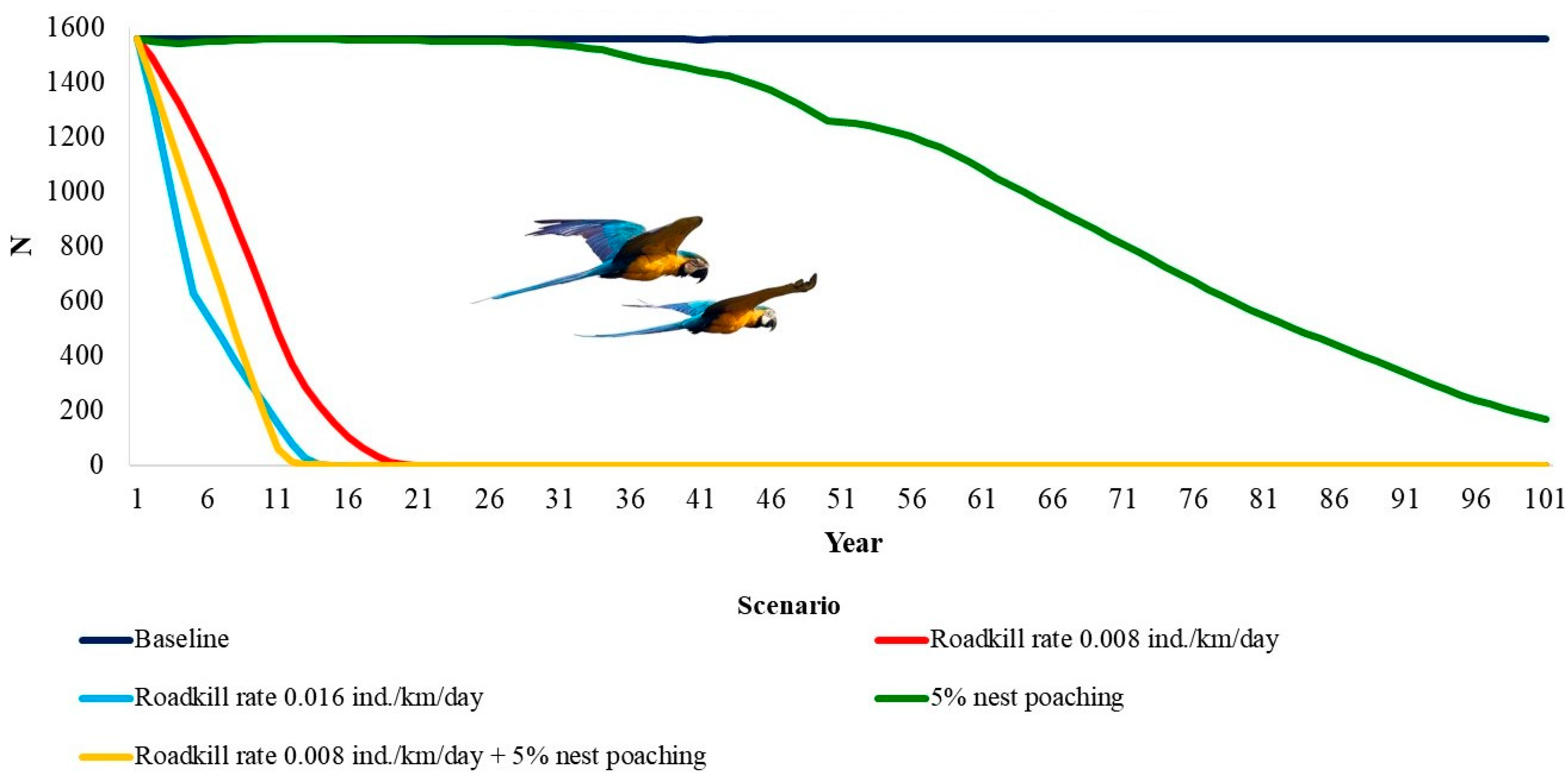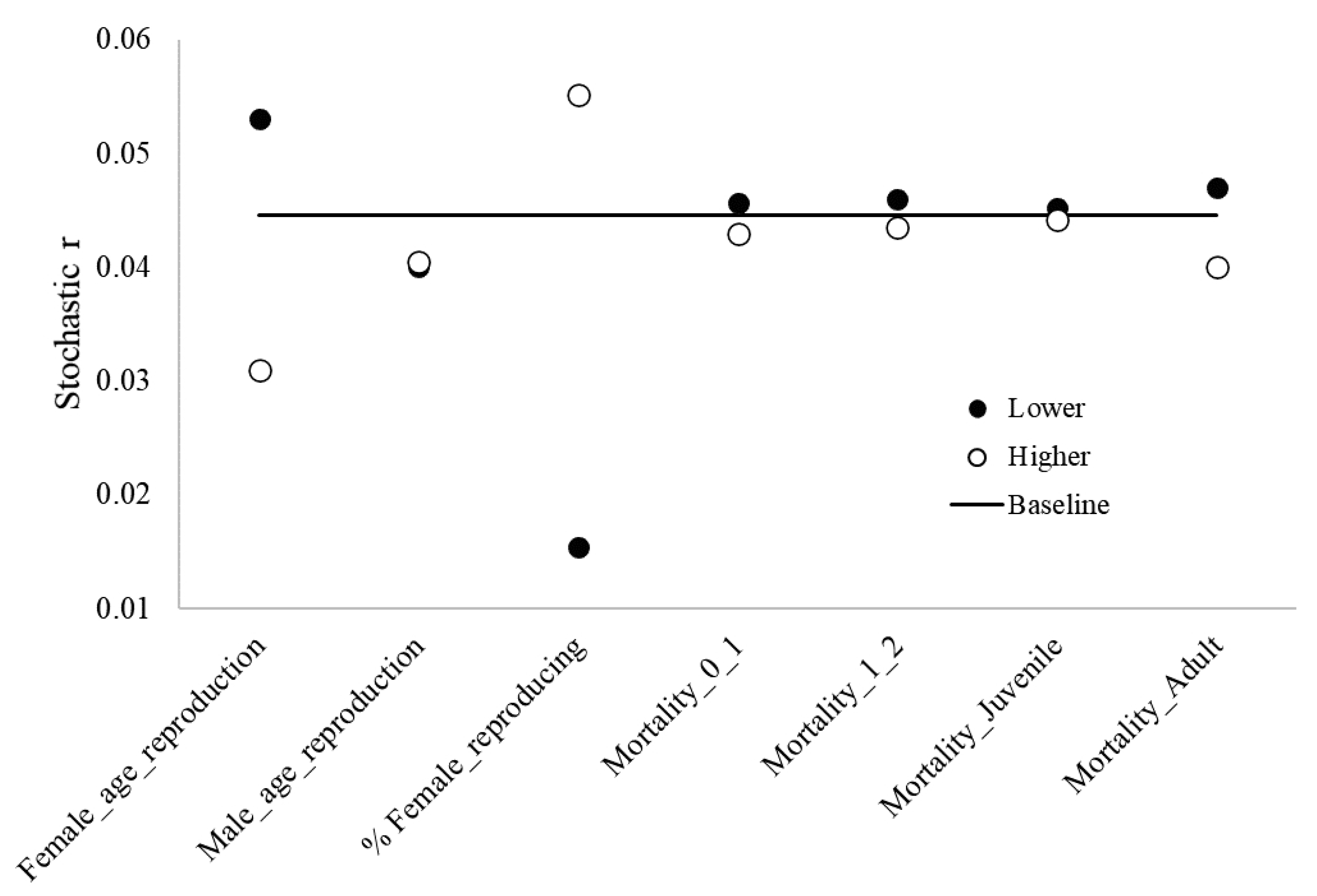Assessing the Relative Impacts of Roadkill and Nest Poaching on the Population Viability of the Blue-and-Yellow Macaw, Ara ararauna (Aves: Psittaciformes), in a Brazilian National Park
Abstract
:1. Introduction
2. Material and Methods
2.1. Study Area
2.2. Modeling
3. Results
4. Discussion
Author Contributions
Funding
Institutional Review Board Statement
Informed Consent Statement
Data Availability Statement
Acknowledgments
Conflicts of Interest
References
- Primack, R.B.; Rodrigues, E. Biologia da Conservação; Planta: Londrina, Brazil, 2001; ISBN 8590200213. [Google Scholar]
- Brook, B.W.; O’Grady, J.J.; Chapman, A.P.; Burgman, M.A.; Resit Akçakaya, H.; Frankham, R. Predictive accuracy of population viability analysis in conservation biology. Nature 2000, 404, 385–387. [Google Scholar] [CrossRef]
- Hileman, E.T.; King, R.B.; Faust, L.J. Eastern massasauga demography and extinction risk under prescribed-fire scenarios. J. Wildl. Manage. 2018, 82, 977–990. [Google Scholar] [CrossRef]
- Pinto, F.A.S.; Bager, A.; Clevenger, A.P.; Grilo, C. Giant anteater (Myrmecophaga tridactyla) conservation in Brazil: Analysing the relative effects of fragmentation and mortality due to roads. Biol. Conserv. 2018, 228, 148–157. [Google Scholar] [CrossRef]
- Cardillo, M.; Mace, G.M.; Jones, K.E.; Bielby, J.; Bininda-Emonds, O.R.P.; Sechrest, W.; Orme, C.D.L.; Purvis, A. Evolution: Multiple causes of high extinction risk in large mammal species. Science 2005, 309, 1239–1241. [Google Scholar] [CrossRef] [Green Version]
- Cáceres, N.C.; Hannibal, W.; Freitas, D.R.; Silva, E.L.; Roman, C.; Casella, J. Mammal occurrence and roadkill in two adjacent ecoregions (Atlantic Forest and Cerrado) in south-western Brazil. Zoologia 2010, 27, 709–717. [Google Scholar] [CrossRef] [Green Version]
- Ceia-Hasse, A.; Borda-de-Água, L.; Grilo, C.; Pereira, H.M. Global exposure of carnivores to roads. Glob. Ecol. Biogeogr. 2017, 26, 592–600. [Google Scholar] [CrossRef] [Green Version]
- Schwartz, A.L.W.; Shilling, F.M.; Perkins, S.E. The value of monitoring wildlife roadkill. Eur. J. Wildl. Res. 2020, 66, 18. [Google Scholar] [CrossRef] [Green Version]
- Ruiz-Capillas, P.; Mata, C.; Malo, J.E. How many rodents die on the road? Biological and methodological implications from a small mammals’ roadkill assessment on a Spanish motorway. Ecol. Res. 2015, 30, 417–427. [Google Scholar] [CrossRef]
- Cullen, L.; Stanton, J.C.; Lima, F.; Uezu, A.; Perilli, M.L.L.; Resit Akcakaya, H. Implications of fine-grained habitat fragmentation and road mortality for jaguar conservation in the atlantic forest, Brazil. PLoS ONE 2016, 11, e0167372. [Google Scholar] [CrossRef]
- Diniz, M.F.; Brito, D. Threats to and viability of the giant anteater, Myrmecophaga tridactyla (Pilosa: Myrmecophagidae), in a protected Cerrado remnant encroached by urban expansion in central Brazil. Zoologia 2013, 30, 151–156. [Google Scholar] [CrossRef] [Green Version]
- Barbosa, P.; Schumaker, N.H.; Brandon, K.R.; Bager, A.; Grilo, C. Simulating the consequences of roads for wildlife population dynamics. Landsc. Urban Plan. 2020, 193, 103672. [Google Scholar] [CrossRef] [PubMed]
- González-Suárez, M.; Zanchetta, F.F.; Grilo, C. Spatial and species-level predictions of road mortality risk using trait data. Glob. Ecol. Biogeogr. 2018, 27, 1093–1105. [Google Scholar] [CrossRef] [Green Version]
- Kociolek, A.; Grilo, C.; Jacobson, S. Flight doesn’t solve everything: Mitigation of road impacts on birds. In Handbook of Road Ecology; van der Ree, R., Smith, D.J., Grilo, C., Eds.; John Wiley & Sons: Hoboken, NJ, USA, 2015; pp. 281–289. [Google Scholar]
- Pinto, F.A.S.; Clevenger, A.P.; Grilo, C. Effects of roads on terrestrial vertebrate species in Latin America. Environ. Impact Assess. Rev. 2020, 81, 106337. [Google Scholar] [CrossRef]
- Lewinsohn, T.M.; Prado, P.I. How many species are there in Brazil? Conserv. Biol. 2005, 19, 619–624. [Google Scholar] [CrossRef]
- Silva, J.M.C. Birds of the Cerrado Region, South America. Steenstrupia 1995, 21, 69–92. [Google Scholar]
- Sick, H. Ornitologia brasileira; Nova Fronteira: Rio de Janeiro, Brazil, 1997; ISBN 8520908160. [Google Scholar]
- BirdLife International. Ara ararauna. The IUCN Red List of Threatened Species. 2018. Available online: https://www.iucnredlist.org/species/22685539/131917270 (accessed on 29 March 2021).
- Ragusa-Netto, J. Dry fruits and the abundance of the Blue-and-Yellow Macaw (Ara ararauna) at a cerrado remnant in central Brazil. Ornitol. Neotrop. 2006, 17, 491–500. [Google Scholar]
- Tubelis, D.P. Feeding ecology of Ara ararauna (Aves, Psittacidae) at firebreaks in western Cerrado, Brazil. Biotemas 2011, 22, 105–115. [Google Scholar] [CrossRef] [Green Version]
- Gwynne, J.A.; Ridgely, R.S.; Argel, M.; Tudor, G. Aves do Brasil. Pantanal & Cerrado; Editora Horizonte: São Paulo, Brazil, 2010; ISBN 9788588031296. [Google Scholar]
- Brightsmith, D.J.; Boyd, J.D.; Hobson, E.A.; Randel, C.J. Satellite telemetry reveals complex migratory movement patterns of two large macaw species in the western amazon basin. Avian Conserv. Ecol. 2021, 16, 14. [Google Scholar] [CrossRef]
- Barbosa, L.T. Avaliação do Sucesso Reprodutivo da Arara-Canindé (Ara ararauna—Psittacidae) e o Desenvolvimetno de Campo Grande. Ph.D. Dissertation, Universidade Anhanguera-Uniderp, Campo Grande, MS, Brazil, 2015. [Google Scholar]
- Bianchi, C.A.C. Biologia Reprodutiva da Arara Canindé (Ara ararauna, Psittacidae) No Parque Nacional das Emas. Ph.D. Dissertation, Universidade de Brasília, Brasília, GO, Brazil, 1998. [Google Scholar]
- Brightsmith, D.; Bravo, A. Ecology and management of nesting blue-and-yellow macaws (Ara ararauna) in Mauritia palm swamps. Biodivers. Conserv. 2006, 15, 4271–4287. [Google Scholar] [CrossRef]
- ICMBio. Instituto Chico Mendes de Conservação da Biodiversidade. Livro Vermelho da Fauna Brasileira Ameaçada de Extinção25; ICMBio: Brasília, Brazil, 2018; ISBN 9788561842796. [Google Scholar]
- Renctas. 1st National Report on the Traffic of Wild Animals; Renctas: Brasília, Brazil, 2001. [Google Scholar]
- Halle, B.O. Bird ’s-Eye View: Lessons from 50 Years of Bird Trade Regulation & Conservation in Amazon Countries; TRAFFIC: Cambridge, UK, 2018. [Google Scholar]
- Chan, D.T.C.; Poon, E.S.K.; Wong, A.T.C.; Sin, S.Y.W. Global trade in parrots—Influential factors of trade and implications for conservation. Glob. Ecol. Conserv. 2021, 30, e01784. [Google Scholar] [CrossRef]
- Romero-Vidal, P.; Hiraldo, F.; Rosseto, F.; Blanco, G.; Carrete, M.; Tella, J.L. Opportunistic or non-random wildlife crime? Attractiveness rather than abundance in the wild leads to selective parrot poaching. Diversity 2020, 12, 314. [Google Scholar] [CrossRef]
- Alves, R.R.N.; Lima, J.R.d.F.; Araujo, H.F.P. The live bird trade in Brazil and its conservation implications: An overview. Bird Conserv. Int. 2012, 23, 53–65. [Google Scholar] [CrossRef] [Green Version]
- Charity, S.; Ferreira, J.M. Wildlife Trafficking in Brazil; TRAFFIC International: Cambridge, UK, 2020. [Google Scholar]
- Marques, D. Operação Contra Tráfico de Fauna e Caça em Unidades de Conservação de AL: 376 Animais Resgatados. Available online: https://faunanews.com.br/2020/07/03/operacao-contra-trafico-de-fauna-e-caca-em-unidades-de-conservacao-de-al-376-animais-resgatados/ (accessed on 10 November 2021).
- Tubelis, D.P. When a large reserve is not large enough to protect part of a population: Blue-and-yellow Macaws (Ara ararauna) in central Brazil. Rev. Biotemas Biotemas 2010, 23, 137–141. [Google Scholar]
- Carvalho-Roel, C.F.; Alves, G.B.; Almeida, A.T.D.; Moreira, R.A.; Tôrres, N.M.; Silveira, L. Wildlife roadkill in the surroundings of Emas National Park, Cerrado Biome, Brazil. Oecologia Aust. 2021, 25, 795–806. [Google Scholar]
- IBAMA—Instituto Brasileiro de Meio Ambiente e Recursos Naturais Renováveis. Plano de Manejo—Parque Nacional das Emas; IBAMA: Brasília, DF, Brazil, 2004. [Google Scholar]
- Rodrigues, F.H.G.; Silveira, L.; Jácomo, A.T.A.; Carmignotto, A.P.; Bezerra, A.M.R.; Coelho, D.C.; Garbogini, H.; Pagnozzi, J.; Hass, A. Composição e caracterização da fauna de mamíferos do Parque Nacional das Emas, Goias, Brasil. Rev. Bras. Zool. 2002, 19, 589–600. [Google Scholar] [CrossRef] [Green Version]
- Oréades, N.d.G. Mapa de Uso e Cobertura Do Solo; NGO Oréades Núcleo de Geoprocessamento: Mineiros, Brazil, 2017. [Google Scholar]
- Martins, A.P.; Damasceno, C.E.; Oliveira, B.J.S. Análise da paisagem na zona de amortecimento do Parque Nacional das Emas –Brasil. Geog Ens Pesq. 2020, 24, 1–36. [Google Scholar] [CrossRef]
- Lacy, R.C.; Miller, P.S.; Traylor-Holzer, K. Vortex 10 User’s Manual; IUCN SSC Conservation Planning Specialist Group, and Chicago Zoological Society: Apple Valley, MN, USA, 2020; ISBN 0120137046. [Google Scholar]
- Medici, E.P.; Desbiez, A.L.J. Population viability analysis: Using a modeling tool to assess the viability of tapir populations in fragmented landscapes. Integr. Zool. 2012, 7, 356–372. [Google Scholar] [CrossRef]
- Young, A.M.; Hobsona, E.A.; Lackey, L.B.; Wrighta, T.F. Survival on the ark: Life history trends in captive parrots. Anim. Conserv. 2012, 15, 28–53. [Google Scholar] [CrossRef] [Green Version]
- Campos, I.B.; Lugarini, C.; de Sousa, A.E.B.; Barbosa, A.E.A.; Miyaki, C.Y.; Aguilar, T.M.; do Amaral, A.C.A.; Linares, S.F.T.P.; do Nascimento, J.L.X.; de Barros, Y.; et al. De Análise de viabilidade populacional de uma população de arara-azul-de-lear. In Plano de Ação Nacional para Conservaçaõ da Arara-Azul-de-Lear; Lugarini, C., Barbosa, A.E.A., de Oliveira, K.G., Eds.; Instituo Chico Mendes de Conservação da Biodiversidade—ICMBio: Brasília, Brazil, 2012; pp. 48–57. [Google Scholar]
- Caparroz, R.; Guedes, N.M.R.; Bianchi, C.A.; Wajntal, A. Analysis of the genetic variability and breeding behaviour of wild populations of two Macaw species (Psittaciformes, Aves) by DNA fingerprinting. Ararajuba 2001, 9, 43–49. [Google Scholar]
- Strem, R.I.; Bouzat, J.L. Population viability analysis of the Blue-throated Macaw (Ara glaucogularis) using individual-based and cohort-based PVA programs. Open Conserv. Biol. J. 2012, 6, 12–24. [Google Scholar] [CrossRef] [Green Version]
- Tella, J.L.; Rojas, A.; Carrete, M.; Hiraldo, F. Simple assessments of age and spatial population structure can aid conservation of poorly known species. Biol. Conserv. 2013, 167, 425–434. [Google Scholar] [CrossRef]
- Pacífico, E.C.; Barbosa, E.A.; Filadelfo, T.; Oliveira, K.G.; Silveira, L.F.; Tella, J.L. Breeding to non-breeding population ratio and breeding performance of the globally Endangered Lear’s Macaw Anodorhynchus leari: Conservation and monitoring implications. Bird Conserv. Int. 2014, 24, 466–476. [Google Scholar] [CrossRef]
- Wyatt, S. Ara Ara glaucogularis. Anim. Divers. Web. 2011, pp. 1–11. Available online: https://animaldiversity.org/accounts/Ara_glaucogularis/ (accessed on 13 November 2021).
- Lloyd, H. Habitat and population estimates of some threatened lowland forest bird species in Tambopata, south-east Peru. Bird Conserv. Int. 2004, 14, 261–277. [Google Scholar] [CrossRef] [Green Version]
- Tella, J.L.; Romero-Vidal, P.; Dénes, F.V.; Hiraldo, F.; Toledo, B.; Rossetto, F.; Blanco, G.; Hernández-Brito, D.; Pacífico, E.; Díaz-Luque, J.A.; et al. Roadside car surveys: Methodological constraints and solutions for estimating parrot abundances across the world. Diversity 2021, 13, 300. [Google Scholar] [CrossRef]
- Pereira, W.G.; Assis, J.d.R.; Basile, I.S.; Custódio, A.E.I.; Veloso, A.C.; Carvalho-Roel, C.F. Sazonalidade e Pavimentação Afetam as Taxas de Atropelamento de Animais Silvestres na Rodovia MGC-455, Uberlândia-Rio Do Peixe; Unpublished Manuscript, Last Modified; 11 November 2021. [Google Scholar]
- González, J.A. Harvesting, local trade, and conservation of parrots in the Northeastern Peruvian Amazon. Biol. Conserv. 2003, 114, 437–446. [Google Scholar] [CrossRef]
- Boyce, M.S. Population viability analysis. Annu. Rev. Ecol. Syst. 1992, 23, 481–506. [Google Scholar] [CrossRef]
- Jacobson, S.L.; Bliss-ketchum, L.L.; Rivera, C.E.D.; Smith, W.P. A behavior-based framework for assessing barrier effects to wildlife from vehicle traffic volume. Ecosphere 2016, 7, e01345. [Google Scholar] [CrossRef]
- Maestri, M.L.; Ferrati, R.; Berkunsky, I. Evaluating management strategies in the conservation of the critically endangered Blue-throated Macaw (Ara glaucogularis). Ecol. Modell. 2017, 361, 74–79. [Google Scholar] [CrossRef]
- Laurance, W.F.; Goosem, M.; Laurance, S.G.W. Impacts of roads and linear clearings on tropical forests. Trends Ecol. Evol. 2009, 24, 659–669. [Google Scholar] [CrossRef]
- Sánchez-Mercado, A.; Ferrer-Paris, J.R.; Rodríguez, J.P.; Tella, J.L. A literature synthesis of actions to tackle illegal parrot trade. Diversity 2021, 13, 191. [Google Scholar] [CrossRef]



| Parameter | Value | Source |
|---|---|---|
| Reproductive system | Long-term monogamy | [18] |
| Age of first offspring females | 11 | [43] |
| Maximum age of female reproduction | 34 | [43] |
| Age of first offspring males | 11 | [43] |
| Maximum age of male reproduction | 34 | [43] |
| Maximum lifespan | 49 | [43] |
| Maximum number of broods per year | 1 | [25] |
| Maximum number of progeny per brood | 2 | [25] |
| Sex ratio at birth—in % males | 50 | [45] |
| % adult females breeding | 36.5% | [47] |
| Distribution of broods per year | ||
| 0 broods | 28% | [25] |
| 1 brood | 72% | [25] |
| Distribution of offspring per year | ||
| 1 offspring | 76.9% | |
| 2 offspring | 23.1% | [25] |
| Mortality rates | ||
| Females from age 0 to 1 | 7% | [44] |
| Females from age 1 to 2 | 5% | [44] |
| Females from age 2 to adult | 2% | [44] |
| Adult females | 1% | [44] |
| Males from age 0 to 1 | 7% | [44] |
| Males from age 1 to 2 | 5% | [44] |
| Males from age 2 to adult | 2% | [44] |
| Adult males | 1% | [44] |
| Catastrophes | - | |
| Initial population size | 1558 | [50,51] |
| Carrying capacity | 1558 | [50,51] |
| Parameter | Lower | Baseline | Higher | |
|---|---|---|---|---|
| Age of first offspring females | 8 * | 11 | 15 * | |
| Age of first offspring males | 8 * | 11 | 15 * | |
| % adult females breeding | 20% ** | 36.5% | 45% | |
| Mortality rates | ||||
| From age 0 to 1 | 5% | 7% | 10% | |
| From age 1 to 2 | 2.5% | 5% | 7% | |
| From age 2 to adult | 1% | 2% | 3% | |
| Adult | 0.5% | 1% | 2% |
| Scenario | Stoch_r | PE | N-Extant | GeneDiv | MeanTE |
|---|---|---|---|---|---|
| Baseline | 0.045 | 0% | 1558 | 99.62% | 0 |
| RK—0.008 individuals/km/day | −0.282 | 100% | 0 | 0% | 19 |
| 2 RK | −0.365 | 100% | 0 | 0% | 13 |
| 5% Nest poaching | −0.024 | 4.8% | 188 | 98.86% | 98 |
| RK + 5% Nest poaching | −0.397 | 100% | 0 | 0% | 12 |
| Scenario | Population Size (N) | Stoch_r | PE | N-Extant | GeneDiv | MeanTE |
|---|---|---|---|---|---|---|
| Baseline | 100 | 0.0418 | 0.00% | 100 | 94.38% | 0 |
| Baseline | 150 | 0.043 | 0.00% | 150 | 96.18% | 0 |
| RK—0.008 individuals/km/day | 3500 | 0.0014 | 2.30% | 3375 | 99.79% | 92 |
| RK | 4000 | 0.0093 | 0.00% | 3992 | 99.85% | 0 |
| 2 RK | 7000 | 0.0025 | 1.30% | 6864 | 99.91% | 88 |
| 2 RK | 7500 | 0.0069 | 0.00% | 7480 | 99.92% | 0 |
| 5% Nest poaching | 1558 | −0.024 | 4.80% | 188 | 98.86% | 98 |
| 5% Nest poaching | 2000 | 0.0112 | 0.00% | 1979 | 99.75% | 0 |
| RK + 5% Nest poaching | 4500 | −0.0148 | 22.20% | 3619 | 99.80% | 85 |
| RK + 5% Nest poaching | 5000 | 0.0059 | 0.00% | 4974 | 99.89% | 0 |
Publisher’s Note: MDPI stays neutral with regard to jurisdictional claims in published maps and institutional affiliations. |
© 2021 by the authors. Licensee MDPI, Basel, Switzerland. This article is an open access article distributed under the terms and conditions of the Creative Commons Attribution (CC BY) license (https://creativecommons.org/licenses/by/4.0/).
Share and Cite
Carvalho-Roel, C.F.; Júnior, O.M. Assessing the Relative Impacts of Roadkill and Nest Poaching on the Population Viability of the Blue-and-Yellow Macaw, Ara ararauna (Aves: Psittaciformes), in a Brazilian National Park. Diversity 2021, 13, 652. https://doi.org/10.3390/d13120652
Carvalho-Roel CF, Júnior OM. Assessing the Relative Impacts of Roadkill and Nest Poaching on the Population Viability of the Blue-and-Yellow Macaw, Ara ararauna (Aves: Psittaciformes), in a Brazilian National Park. Diversity. 2021; 13(12):652. https://doi.org/10.3390/d13120652
Chicago/Turabian StyleCarvalho-Roel, Carine Firmino, and Oswaldo Marçal Júnior. 2021. "Assessing the Relative Impacts of Roadkill and Nest Poaching on the Population Viability of the Blue-and-Yellow Macaw, Ara ararauna (Aves: Psittaciformes), in a Brazilian National Park" Diversity 13, no. 12: 652. https://doi.org/10.3390/d13120652
APA StyleCarvalho-Roel, C. F., & Júnior, O. M. (2021). Assessing the Relative Impacts of Roadkill and Nest Poaching on the Population Viability of the Blue-and-Yellow Macaw, Ara ararauna (Aves: Psittaciformes), in a Brazilian National Park. Diversity, 13(12), 652. https://doi.org/10.3390/d13120652






